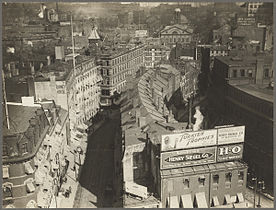42°21′34.58″N 71°3′27.81″W / 42.3596056°N 71.0577250°W

Cornhill was a street in Boston, Massachusetts, in the 18th, 19th and 20th centuries, located on the site of the current City Hall Plaza in Government Center. It was named in 1829; previously it was known as Market Street (1807–1828).[1][2] In its time, it comprised a busy part of the city near Brattle Street, Court Street and Scollay Square. In the 19th century, it was the home of many bookstores and publishing companies.[3] As of 1969, Cornhill exists as 144 feet along the edge of City Hall Plaza.[4]
-
Detail of 1826 map of Boston, showing Market Street (renamed Cornhill in 1828)
-
Detail of 1832 map of Boston, showing Cornhill and vicinity
-
Cornhill, c. 1836. Shows shops of Light & Horton; Gerry & Burt; George W. Light; Peck & Co.; William Peirce; etc.
-
Advertising for the Prisoner's Friend published on Cornhill, c. 1840s. "Devoted to the abolition of capitol punishment, and the improvement of prison discipline"
-
Advertisement for George C. Rand & Co. printers, 1849
-
Advertisement for Stephen Smith's Desk Warehouse, 1854
-
Whig Headquarters, 1856
-
Ad for James Campbell, antiquarian bookshop, c. 1860s[5]
-
c. 1897
-
Cornhill, Boston, c. 1905
-
Overview of Brattle St. (left), Cornhill (right), and Faneuil Hall (upper right), c. 1920
See also
edit- City Hall Plaza
- Sears' Crescent building (built 1816) 100 City Hall Plaza; formerly 38–68 Cornhill)[6][7]
- Sears' Block (built 1848) corner Court + Washington St., formerly 70–72 Cornhill[6][7]
Previous tenants of Cornhill
- Annin & Smith, 19th-century engravers[8]
- Iver Johnson Sporting Goods Company, Located in the Iver Johnson Building, corner of Washington Street and Cornhill
- Daniel Clement Colesworthy, bookseller, c. 1850s[9]
- Frost & Adams, art supplies
- The Liberator (anti-slavery newspaper), published by Isaac Knapp, Cornhill, c. 1837[10]
- Bela Marsh, 19th century publisher
- F. T. Somerby, painter
References
edit- ^ Edward Hartwell Savage (1886), Boston events, Boston: Mutual News Co.
- ^ From 1708 to 1824, a portion of Washington Street was known as "Cornhill;" cf. Boston (Mass.). Street laying-out Dept. (1910), A record of the streets, alleys, places, etc. in the city of Boston (2 ed.), Boston: City of Boston Printing Dept., OL 16574538M
- ^ "Cornhill – Once Boston's Literary Center, Today Replaced by Government Center". Forgotten New England. 5 June 2012. Retrieved 10 May 2016.
- ^ "Public way. Open from Franklin Ave to approximately 144 feet easterly." cf. "Street Book". City of Boston. Retrieved 2010-06-17.
- ^ Boston Directory. 1861
- ^ a b "National Register of Historic Places". U.S. Dept. of the Interior. Retrieved 2010-06-17.
- ^ a b Susan Southworth; Michael Southworth (2008), AIA guide to Boston (3 ed.), Guilford, Conn: Globe Pequot, OCLC 175057014, OL 22549621M
- ^ Boston Directory. 1832
- ^ Boston Directory. 1857
- ^ American Broadsides and Ephemera, Series 1, no. 5153
Further reading
edit- "Old Boston Booksellers: The Three Burnham Brothers and Their Antecedents". The New York Times, July 21, 1893. p. 6, col. 3. (Mentions Samuel B. Drake and Burnham Brothers, booksellers.)
- "Booksellers of Cornhill: 1828-1865" by Alan Seaburg. Published by The Anne Miniver Press (2017). On-line Dropbox edition can be accessed at: anneminiverpress.com
External links
editWikimedia Commons has media related to Cornhill (Boston, Massachusetts).
- Bostonian Society has materials related to the street.
- G. Kepes. Photo of Scollay Square from Pemberton Square Looking Across to Cornhill Street, 1957.
- Flickr. Sears Crescent, 1999
- Flickr. Sears Crescent, 2008
- Flickr. Photo, 2009







![Ad for James Campbell, antiquarian bookshop, c. 1860s[5]](http://upload.wikimedia.org/wikipedia/commons/thumb/8/80/1860_Campbell_Cornhill_Boston.png/178px-1860_Campbell_Cornhill_Boston.png)


